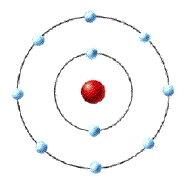Sir Ernest Rutherford
Sir Ernest Rutherford, b. near Nelson, New Zealand, Aug. 30, 1871,
d. Oct. 19, 1937, perhaps more than any other scientist, formed
modern-day views concerning the nature of matter. After
distinguishing himself in his undergraduate work in his native New
Zealand, Rutherford matriculated to Cambridge University's Cavendish
Laboratory, which was at that time under the directorship of Sir
Joseph John Thomson, the leading authority on electromagnetic
phenomena. Rutherford's early work with Thomson led to investigations
of electricity and radiation and eventually to a detailed study of
radioactivity.
In 1898, Rutherford obtained the physics professorship at McGill
University, Montreal, and soon demonstrated his talents by
discovering several radioactive elements. Although others had
pioneered the earliest developments in radioactivity, Rutherford soon
achieved dominance in this field. He found that at least two kinds of
radiation, which he labeled alpha and beta, existed.
|
Working with Frederick Soddy in 1902-03, Rutherford
identified the phenomenon of radioactive half-life and
formulated the still-accepted explanation of radioactivity:
each decay of the atoms of radioactive materials signifies
the transmutation of a parent element into a daughter, with
each type of atom having its own transformation period. This
theory stimulated many other scientists, including
Rutherford, to order all known radioactive elements into
their decay series and to search for any missing members.
Rutherford was awarded the 1908 Nobel Prize for chemistry
for his work in radioactivity. Moving to the University of
Manchester in 1907, Rutherford almost immediately began to
examine alpha particles because, since they were relatively
massive and of atomic dimensions, he felt that they were the
key to understanding the nature of matter. Indeed,
Rutherford and Hans Geiger showed (1908) conclusively that
alpha particles were doubly charged helium ions.
Rutherford made his greatest discovery in 1909. Shortly
after his move to Manchester, he found that a few alpha
particles, when bombarding thin metal foils, were deflected
from their incident beam through more than 90 deg. "It was
almost as incredible," Rutherford later responded in a
now-classic statement, "as if you fired a fifteen-inch shell
at a piece of tissue paper and it came back and hit you."
Early in 1911 he finally announced his version of the
structure of the atom:
|

|
a very small, tightly packed, charged nucleus sprinkled with
opposite charges in the mostly empty surrounding void. The deflected
alpha particles were those that had come into close proximity with
the nucleus and had rebounded in various oblique directions.
In 1898, Rutherford obtained the physics professorship at McGill
University, Montreal, and soon demonstrated his talents by
discovering several radioactive elements. Although others had
pioneered the earliest developments in radioactivity, Rutherford soon
achieved dominance in this field. He found that at least two kinds of
radiation, which he labeled alpha and beta, existed.

|
Working with Frederick Soddy in 1902-03, Rutherford
identified the phenomenon of radioactive half-life and
formulated the still-accepted explanation of radioactivity:
each decay of the atoms of radioactive materials signifies
the transmutation of a parent element into a daughter, with
each type of atom having its own transformation period. This
theory stimulated many other scientists, including
Rutherford, to order all known radioactive elements into
their decay series and to search for any missing members.
Rutherford was awarded the 1908 Nobel Prize for chemistry
for his work in radioactivity. Moving to the University of
Manchester in 1907, Rutherford almost immediately began to
examine alpha particles because, since they were relatively
massive and of atomic dimensions, he felt that they were the
key to understanding the nature of matter. Indeed,
Rutherford and Hans Geiger showed (1908) conclusively that
alpha particles were doubly charged helium ions.
Rutherford made his greatest discovery in 1909. Shortly
after his move to Manchester, he found that a few alpha
particles, when bombarding thin metal foils, were deflected
from their incident beam through more than 90 deg. "It was
almost as incredible," Rutherford later responded in a
now-classic statement, "as if you fired a fifteen-inch shell
at a piece of tissue paper and it came back and hit you."
|
Early in 1911 he finally announced his version of the
structure of the atom: a very small, tightly packed, charged nucleus
sprinkled with opposite charges in the mostly empty surrounding void.
The deflected alpha particles were those that had come into close
proximity with the nucleus and had rebounded in various oblique
directions.
About the time that Rutherford moved (1919) to Cambridge to
succeed Thomson as director of the Cavendish Laboratory, he
discovered artificial disintegration--the artificial splitting of the
atom--a signal discovery that presaged his entry into the field of
nuclear physics. Members of his Cavendish team discovered the neutron
and the disintegration phenomena produced by artificially accelerated
particles.
Rutherford was president (1925-30) of the Royal Society, which had
given him its highest award, the Copley Medal, in 1922. Rutherford
was knighted in 1914, raised to the peerage in 1931, and awarded the
Order of Merit in 1921.
Erich Robert Paul
Bibliography: Andrade, E. N., Rutherford and the Nature of the
Atom (1964); Bunge, M., and Shea, W. R., eds., Rutherford and Physics
at the Turn of the Century (1979); Kelman, Peter, and Stone, A. H.,
Ernest Rutherford: Architect of the Atom (1968); Wilson, David,
Rutherford, Simple Genius (1983).
Last modified on: Thursday, October 30, 1997.

